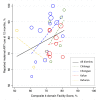Associations between health systems capacity and mother-to-child HIV prevention program outcomes in Zambia
- PMID: 30192777
- PMCID: PMC6128540
- DOI: 10.1371/journal.pone.0202889
Associations between health systems capacity and mother-to-child HIV prevention program outcomes in Zambia
Abstract
Introduction: Zambia has made substantial investments in health systems capacity, yet it remains unclear whether improved service quality improves outcomes. We investigated the association between health system capacity and use of prevention of mother-to-child HIV transmission (PMTCT) services in Zambia.
Materials and methods: We analyzed data from two studies conducted in rural and semi-urban Lusaka Province in 2014-2015. Health system capacity, our primary exposure, was measured with a validated balanced scorecard approach. Based on WHO building blocks for health systems strengthening, we derived overall and domain-specific facility scores (range: 0-100), with higher scores indicating greater capacity. Our outcome, community-level maternal antiretroviral drug use at 12 months postpartum, was measured via self-report in a large cohort study evaluating PMTCT program impact. Associations between health systems capacity and our outcome were analyzed via linear regression.
Results: Among 29 facilities, median overall facility score was 72 (IQR:67-74). Median domain scores were: patient satisfaction 75 (IQR 71-78); human resources 85 (IQR:63-87); finance 50 (IQR:50-67); governance 82 (IQR:74-91); service capacity 77 (IQR:68-79); service provision 60 (IQR:52-76). Our programmatic outcome was measured from 804 HIV-infected mothers. Median community-level antiretroviral use at 12 months was 81% (IQR:69-89%). Patient satisfaction was the only domain score significantly associated with 12-month maternal antiretroviral use (β:0.22; p = 0.02). When we excluded the human resources and finance domains, we found a positive association between composite 4-domain facility score and 12-month maternal antiretroviral use in peri-urban but not rural facilities.
Conclusions: In these Zambian health facilities, patient satisfaction was positively associated with maternal antiretroviral 12 months postpartum. The association between overall health system capacity and maternal antiretroviral drug use was stronger in peri-urban versus rural facilities. Additional work is needed to guide strategic investments for improved outcomes in HIV and broader maternal-child health region-wide.
Conflict of interest statement
The authors declare that no competing interests exist.
Figures




References
-
- Chi BH, Adler MR, Bolu O, Mbori-Ngacha D, Ekouevi DK, Gieselman A, et al. Progress, challenges, and new opportunities for the prevention of mother-to-child transmission of HIV under the US President's Emergency Plan for AIDS Relief. J Acquir Immune Defic Syndr. 2012;60 Suppl 3:S78–87. 10.1097/QAI.0b013e31825f3284 . - DOI - PMC - PubMed
-
- World Health Organization. Consolidated guidelines on the use of antiretroviral drugs for treating and preventing HIV infection: recommendations for a public health approach. 2nd edition, 2016. http://apps.who.int/iris/bitstream/10665/208825/1/9789241549684_eng.pdf. Accessed on July 27, 2017. - PubMed
-
- UN Joint Programme on HIV/AIDS (UNAIDS). 2015 Progress Report on the Global Plan towards the elimination of new HIV infections among children by 2015 and keeping their mothers alive. 2015. http://www.unaids.org/sites/default/files/media_asset/JC2774_2015Progres.... Accessed October 29, 2017.
Publication types
MeSH terms
Substances
Grants and funding
LinkOut - more resources
Full Text Sources
Other Literature Sources
Medical

